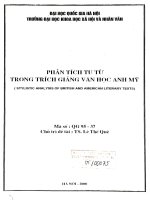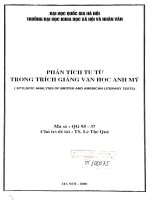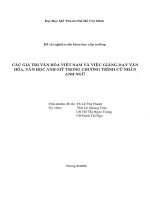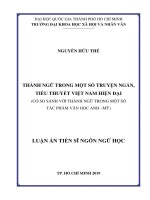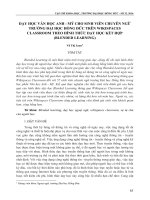En16 văn học anh mỹ bài 5
Bạn đang xem bản rút gọn của tài liệu. Xem và tải ngay bản đầy đủ của tài liệu tại đây (51.35 KB, 4 trang )
<span class="text_page_counter">Trang 1</span><div class="page_container" data-page="1">
<b>HANOI OPEN UNIVERSITYMID -TERM TEST ON ENGLISH AND AMERICANLITERATURE </b>
<small>FOR STUDENTS OF ENGLISH (No 2)</small>Subject Code: EN16
Full name: Date of birth: Group:
<b>ĐỀ 2:I. Answer the following questions: (50 points )</b>
1. What three languages were spoken in England in the 11th - 13th centuries, and whom were they spoken by? Mention some reasons.
2. What is a romance, a fabliaux, a bestiaria? In what language were they written?(The file sent will be named after each student’s name. Plagiarism will lead to failure)
<b>II. Comments (50 points ) </b>
Write what you know about the life and works of Geoffrey Chaucer - The founder of English realism
<b>I. Answer the following questions: (50 points )</b>
<b>Task 1: </b>
During the 11th to 13th centuries, three languages were spoken in England: Old English, Anglo-Norman, and Latin.1. Old English: Old English was the native language of the Anglo-Saxons and was spokenby the common people. It evolved from the Germanic languages brought to England by the Anglo-Saxon settlers. Old English was the language of the majority of the population, including farmers, craftsmen, and the lower social classes.
2. Anglo-Norman: Anglo-Norman was a variety of Old Norman spoken by the Norman conquerors and the ruling elite. Following the Norman Conquest in 1066, the Norman nobility brought their language to England. Anglo-Norman was primarily spoken by the
</div><span class="text_page_counter">Trang 2</span><div class="page_container" data-page="2">aristocracy, the upper classes, and the legal and administrative systems. It was also the language of the English royal court.
3. Latin: Latin was the language of the Church and the educated clergy. It was used for religious ceremonies, scholarly writings, and official documents. Latin was the language of the Catholic Church, and as such, it was used in religious services, theological debates,and the education of clergy members.
These three languages coexisted in England for various reasons:
1. Social Hierarchy: The linguistic division reflected the social hierarchy of the time. Old English was spoken by the common people, Anglo-Norman by the ruling elite, and Latin by the Church and educated clergy.
2. Norman Conquest: The Norman Conquest of England in 1066 brought the influence of the Norman nobility, who introduced the French-speaking culture and language to the country. Anglo-Norman became the language of the court, administration, and the legal system.
3. Church Influence: Latin was the language of the Church and was used for religious purposes. The Catholic Church held significant power during this period, and Latin was the language of religious texts, ceremonies, and scholarly works.
4. Cultural Exchange: The coexistence of these languages also resulted from cultural exchange and interaction between the different social groups in England. The languages influenced each other, leading to the development of Middle English, which emerged as ablend of Old English and Anglo-Norman.
It's worth noting that the dominance of these languages shifted over time, and by the end of the 13th century, Middle English began to emerge as the primary language spoken in England.
<b>Task 2: A romance, a fabliau, and a bestiary are different types of literary works from the</b>
medieval period, written in various languages.
1. Romance: A romance is a genre of medieval literature that typically revolves around chivalry, knights, and courtly love. These stories often feature heroic quests, adventures, and romantic relationships. Romances were written in various languages, including Old French, Middle English, and Old Spanish. Some famous examples include "Le Morte d'Arthur" by Thomas Malory and "Tristan and Iseult."
2. Fabliau: A fabliau is a genre of medieval French literature that focuses on humorous and often bawdy tales. These stories typically involve clever tricks, mistaken identities, and social satire. Fabliaux were written in Old French and were popular among the lower
</div><span class="text_page_counter">Trang 3</span><div class="page_container" data-page="3">social classes. They provided a form of entertainment and commentary on social norms and behaviors. Notable examples include "The Miller's Tale" by Geoffrey Chaucer and "La Châtelaine de Vergi."
3. Bestiary: A bestiary is a type of medieval book that describes various animals, both real and mythical, and assigns moral or symbolic meanings to them. Bestiaries were written in Latin and were popular during the 12th and 13th centuries. They were often used as educational tools and moral guides, combining natural history with religious and moral teachings. Some well-known bestiaries include the "Physiologus" and the
"Aberdeen Bestiary."
It's important to note that these literary genres and their associated works were written in different languages and regions, reflecting the cultural diversity and linguistic variations of the medieval period
<b>II. Comments (50 points ) </b>
Geoffrey Chaucer, often referred to as the "Father of English Literature," was a prominent poet and author who lived in the 14th century. He is best known for his masterpiece, "The Canterbury Tales," a collection of stories told by a diverse group of pilgrims traveling to the shrine of Thomas Becket in Canterbury.
Chaucer was born around 1343 in London, England, into a family of wine
merchants. He had connections to the court of King Edward III and served as a diplomat, traveling to various European countries. These experiences exposed him to different cultures and literary traditions, which greatly influenced his writing.
Chaucer's works are considered groundbreaking for their realistic portrayal of characters and their use of vernacular English instead of the traditional Latin or French. He played a significant role in establishing English as a legitimate literary language.
"The Canterbury Tales" is Chaucer's most famous work and showcases his masteryof storytelling. The collection consists of 24 tales, with each pilgrim telling a story on their way to Canterbury. The tales cover a wide range of genres, including romance, fabliau, and moral allegory, providing a vivid depiction of medieval society.
Chaucer's writing style is characterized by his keen observation of human nature, satirical wit, and skillful use of irony. He skillfully captures the diverse voices and personalities of his characters, creating a rich tapestry of medieval life.
Aside from "The Canterbury Tales," Chaucer also wrote other notable works, such as "Troilus and Criseyde," a tragic love story set during the Trojan War, and "The Book
</div><span class="text_page_counter">Trang 4</span><div class="page_container" data-page="4">of the Duchess," a poem mourning the death of John of Gaunt's wife.
Geoffrey Chaucer's contributions to English literature cannot be overstated. His works not only marked a shift towards realism and the use of vernacular language but also laid the foundation for future generations of English writers. His influence can be seen in the works of later authors, such as William Shakespeare and John Milton.
Chaucer's legacy as the founder of English realism continues to resonate in the world of literature today.
</div>


